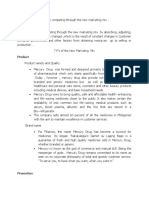0 ratings0% found this document useful (0 votes)
43 viewsEarly 19th Century Rudolph Valentino: George Raft Appeared With Carole Lombard
Early 19th Century Rudolph Valentino: George Raft Appeared With Carole Lombard
Uploaded by
RM ValenciaThis document provides information about 9 basic partner dance positions:
1) One-hand hold position where only one hand is held
2) Two-hand hold position where both hands are held
3) Outside right position where partners stand close in a "V" shape facing the same direction
4) Outside left position is similar but the woman's feet are to the left of the man's
5) Promenade position has partners facing the same direction and moving forward together
6) Fallaway position is like promenade but moving backward
7) Shadow position has one partner following the other's movements
8) Skater's position has hands joined in front at different heights
9) Challenge position has partners facing
Copyright:
© All Rights Reserved
Available Formats
Download as DOCX, PDF, TXT or read online from Scribd
Early 19th Century Rudolph Valentino: George Raft Appeared With Carole Lombard
Early 19th Century Rudolph Valentino: George Raft Appeared With Carole Lombard
Uploaded by
RM Valencia0 ratings0% found this document useful (0 votes)
43 views3 pagesThis document provides information about 9 basic partner dance positions:
1) One-hand hold position where only one hand is held
2) Two-hand hold position where both hands are held
3) Outside right position where partners stand close in a "V" shape facing the same direction
4) Outside left position is similar but the woman's feet are to the left of the man's
5) Promenade position has partners facing the same direction and moving forward together
6) Fallaway position is like promenade but moving backward
7) Shadow position has one partner following the other's movements
8) Skater's position has hands joined in front at different heights
9) Challenge position has partners facing
Original Title
BALLROOM PE
Copyright
© © All Rights Reserved
Available Formats
DOCX, PDF, TXT or read online from Scribd
Share this document
Did you find this document useful?
Is this content inappropriate?
This document provides information about 9 basic partner dance positions:
1) One-hand hold position where only one hand is held
2) Two-hand hold position where both hands are held
3) Outside right position where partners stand close in a "V" shape facing the same direction
4) Outside left position is similar but the woman's feet are to the left of the man's
5) Promenade position has partners facing the same direction and moving forward together
6) Fallaway position is like promenade but moving backward
7) Shadow position has one partner following the other's movements
8) Skater's position has hands joined in front at different heights
9) Challenge position has partners facing
Copyright:
© All Rights Reserved
Available Formats
Download as DOCX, PDF, TXT or read online from Scribd
Download as docx, pdf, or txt
0 ratings0% found this document useful (0 votes)
43 views3 pagesEarly 19th Century Rudolph Valentino: George Raft Appeared With Carole Lombard
Early 19th Century Rudolph Valentino: George Raft Appeared With Carole Lombard
Uploaded by
RM ValenciaThis document provides information about 9 basic partner dance positions:
1) One-hand hold position where only one hand is held
2) Two-hand hold position where both hands are held
3) Outside right position where partners stand close in a "V" shape facing the same direction
4) Outside left position is similar but the woman's feet are to the left of the man's
5) Promenade position has partners facing the same direction and moving forward together
6) Fallaway position is like promenade but moving backward
7) Shadow position has one partner following the other's movements
8) Skater's position has hands joined in front at different heights
9) Challenge position has partners facing
Copyright:
© All Rights Reserved
Available Formats
Download as DOCX, PDF, TXT or read online from Scribd
Download as docx, pdf, or txt
You are on page 1of 3
TITLE YEAR STARTED KNOWN PEOPLE (WHO STARTED)
TANGO early 19th Century Rudolph Valentino
SALSA 1950’s Tony Manero
early 1920’s
RUMBA George Raft appeared
with Carole Lombard
SWING 1920's Frankie Manning
Foxtrot 1914 Arthur Carringford
SAMBA late twenties
Fred Astaire and Dolores
Del Rio
CHA-CHA-CHA 1948 ..1950’s. Enrique Jorrin
WALTZ 19th century Johann Strauss
early 1940s Cab Calloway
JIVE
One-Hand Hold Position
One hand hold. Tracy Wicklund
Jumpstart your ballroom dance lessons by learning these nine basic partner positions. Cab Calloway
First, try the one-hand hold.
In the one-hand hold, only one hand is held. Hence the name.
Try it with the partners facing each other. The other hand is relaxed at their sides. When partners
face each other within arms reach, it is called the open facing position.
02
of 09
Two-Hand Hold
Two hand hold. Tracy Wicklund
In the two-hand hold position, both hands are held. Both partners should stand apart, facing each
other. The man ( or the person holding the traditionally male role) should hold both of the
woman's hands.
03
of 09
Outside Right Position
Outside right position. Tracy Wicklund
The closed position is another common position in ballroom dancing. In the closed position, the
partners stand close enough to each other that their bodies touch, but slightly off to each dancer's
left. Each dancer's right foot should be able to step in between the other person's feet.
In the closed position, the man's right hand rests on the woman's back and he holds her right hand
with his left. The woman places her left hand on his upper arm.
The outside right position (or right parallel) is similar to the basic closed position.
With the outside right position, the feet are different. The woman's feet stand to the right on the
man's.
04
of 09
Outside Left Position
Left outside. Tracy Wicklund
The outside left (or left parallel) position is similar to the basic closed position. Again, the foot
positioning is what's different. In this position, the woman places her feet to the left of the man's.
05
of 09
Promenade Position
Promenade position. Tracy Wicklund
In the promenade position, both partners face the same direction instead of facing each other. The
bodies make a sort of V shape.
Because the dancers are facing the same direction, they also move forward together.
06
of 09
Fallaway Position
Fallaway position. Tracy Wicklund
The fallaway position is similar to the promenade position, except it moves backward instead of
forward. Both partners take small steps backward.
07
of 09
Shadow Position
Shadow position. Tracy Wicklund
In the shadow position, partners "shadow" each other's moves.
Both partners should face the same direction, with one partner either in front of the other or slightly to the left
or right.
Partners should step with the same foot in the same direction. Their movements should act as a shadow to
each other, per the name of the position.
Partners can be closed (touching), semi-closed (slightly apart) or totally apart.
08
of 09
Skater's Position
Skater's position. Tracy Wicklund
In the skater's position, partners join hands in front of their bodies. The right hands should be
joined below and left hands joined above.
09
of 09
Challenge Position
Challenge position. Tracy Wicklund
In the challenge position, the man and woman face each other but are apart and without contact.
You might also like
- Windmill Technique Guide © Aerial PhysiqueDocument12 pagesWindmill Technique Guide © Aerial PhysiqueAndré Paçoca Magalhães100% (1)
- Competing Thru The New Marketing MixDocument6 pagesCompeting Thru The New Marketing MixRM ValenciaNo ratings yet
- Week 5 PE 2 Dance Position With PartnersDocument24 pagesWeek 5 PE 2 Dance Position With PartnersAj SalengaNo ratings yet
- Stage DirectionsDocument5 pagesStage DirectionsAllan Dela CruzNo ratings yet
- Ar Rinci FoirneDocument48 pagesAr Rinci FoirneHelen RoseNo ratings yet
- Drums Alive Routine 1Document3 pagesDrums Alive Routine 1Erin Sandberg100% (1)
- Lesson Plan For Mapeh 9 Social DancesDocument3 pagesLesson Plan For Mapeh 9 Social DancesAnabelle Torrejos Japay50% (2)
- Basic Positions in Social DancingDocument1 pageBasic Positions in Social DancingAlven Villena DicenNo ratings yet
- Pe 102 Rythmic ActivitiesDocument18 pagesPe 102 Rythmic ActivitiesDiana Mae PagcaliwaganNo ratings yet
- Basic Dance PositionDocument4 pagesBasic Dance PositionGera KayeNo ratings yet
- Some International Dance TermsDocument1 pageSome International Dance TermsTINIA MARIE GAYATGAYNo ratings yet
- Intro RumbaDocument3 pagesIntro RumbaHarry Cheung Chi ChungNo ratings yet
- Basic Dance Position in Ballroom DanceDocument5 pagesBasic Dance Position in Ballroom DanceDave Decolas100% (1)
- Salsa Casino Basic-IntermediateDocument8 pagesSalsa Casino Basic-IntermediateLuis TorresNo ratings yet
- English Country Dance StepsDocument4 pagesEnglish Country Dance StepsChiso PhiriNo ratings yet
- Tal Chi Bamboo Stick 2014Document7 pagesTal Chi Bamboo Stick 2014Michael HeimNo ratings yet
- Retro DanceDocument19 pagesRetro DanceRachelle LicosNo ratings yet
- Lisa Wichman: Nafme Eastern Division ConferenceDocument7 pagesLisa Wichman: Nafme Eastern Division ConferenceDarell Sua100% (1)
- Grade 9 TMDocument22 pagesGrade 9 TMbangbangNo ratings yet
- Finals-Ballroom Dances Edited SecondDocument12 pagesFinals-Ballroom Dances Edited Secondjaimenel garciaNo ratings yet
- Common Dance TermsDocument34 pagesCommon Dance TermsKen GorresNo ratings yet
- Dance Terms Common To Folk DancesDocument3 pagesDance Terms Common To Folk DancesHeherson Mel AgaciaNo ratings yet
- Party LevitationDocument6 pagesParty Levitationqlipoth1No ratings yet
- Pe2 Week6-8Document20 pagesPe2 Week6-8dazieljade100% (1)
- DANCESPORT (1)Document2 pagesDANCESPORT (1)denorogjohnlouieNo ratings yet
- Step 9 The Backhand Groundstroke Part1Document15 pagesStep 9 The Backhand Groundstroke Part1humpreydumpyNo ratings yet
- Acid Lemon: by Jack SkillmanDocument2 pagesAcid Lemon: by Jack SkillmanDawid Ch.No ratings yet
- BranslesDocument12 pagesBranslesguido_villetasNo ratings yet
- WaltzDocument3 pagesWaltzValentina KovaleskyNo ratings yet
- Kosakata Minggu 1Document5 pagesKosakata Minggu 1Gilang WibowoNo ratings yet
- Strength Conditioning: Cymbal Line Workout Routine: CymbalsDocument7 pagesStrength Conditioning: Cymbal Line Workout Routine: CymbalsJohn Ringor100% (1)
- Dances of France and BurgundyDocument32 pagesDances of France and BurgundyKatalin FreészNo ratings yet
- Oxford Diocesan Guild of Church Bell RingersDocument12 pagesOxford Diocesan Guild of Church Bell RingersHarold CataquetNo ratings yet
- Unit 3: A Trip To The Countryside: No. Noun Adjective Verb AdverbDocument2 pagesUnit 3: A Trip To The Countryside: No. Noun Adjective Verb AdverbThien DongNo ratings yet
- FSCDance ManualDocument19 pagesFSCDance ManualfredwardwoodNo ratings yet
- Trombone Book 1-23Document44 pagesTrombone Book 1-23tomNo ratings yet
- Stedman Doubles and Triples: Oxford Diocesan Guild of Church Bell RingersDocument12 pagesStedman Doubles and Triples: Oxford Diocesan Guild of Church Bell RingersHarold CataquetNo ratings yet
- BaMuZhangGraphics5 1Document4 pagesBaMuZhangGraphics5 1Teri ChongNo ratings yet
- Passchen RingbuchDocument30 pagesPasschen RingbuchrovingarcherNo ratings yet
- Capoeira BasicsDocument17 pagesCapoeira BasicsElena DitaNo ratings yet
- Dance TermsDocument3 pagesDance Termsminghao's teaNo ratings yet
- Navigate A2 Wordlist - A To Z-1 10Document1 pageNavigate A2 Wordlist - A To Z-1 10marleyyasmintavaredNo ratings yet
- Principles of The Taubman Approach - Robert Durso - Tonebase Workbook 04.18.23Document13 pagesPrinciples of The Taubman Approach - Robert Durso - Tonebase Workbook 04.18.23Ana Pereirinha100% (1)
- Summative Synchronized Swimming Assessment - Dante Tom Cole Richard and JohnDocument5 pagesSummative Synchronized Swimming Assessment - Dante Tom Cole Richard and Johnapi-462319278No ratings yet
- Physical EducationDocument2 pagesPhysical EducationAbdulmohaimen DimarenNo ratings yet
- Taiji Spear Methods According To Chen Yanlin - Brennan TranslationDocument8 pagesTaiji Spear Methods According To Chen Yanlin - Brennan Translationanattā100% (3)
- Dancing The Tarantella With A PartnerDocument7 pagesDancing The Tarantella With A PartnerJirah Joy PeañarNo ratings yet
- List of Break Dance MovesDocument11 pagesList of Break Dance MovesAkshai KsNo ratings yet
- Drum Score / Instruction: DTX 402 SeriesDocument52 pagesDrum Score / Instruction: DTX 402 SeriesFaber Mejia MontesNo ratings yet
- Foreign Folk Dance TerminologiesDocument23 pagesForeign Folk Dance TerminologiesMhin SarandiNo ratings yet
- Bastão Tai Chi Estilo YangDocument21 pagesBastão Tai Chi Estilo YangandreaguirredoamaralNo ratings yet
- Percussion Rudiments: Single Stroke RollDocument5 pagesPercussion Rudiments: Single Stroke RollRaffaele CollazzoNo ratings yet
- Fundamental Dance StepsDocument2 pagesFundamental Dance StepsReginald TobiasNo ratings yet
- Chapter 8 - Social DancingDocument10 pagesChapter 8 - Social DancingLeonardo IV RamosNo ratings yet
- Paul Rolland and His Influence O: by Mimi ZweigDocument3 pagesPaul Rolland and His Influence O: by Mimi ZweignanoNo ratings yet
- Groundwork in Ju JitsuDocument7 pagesGroundwork in Ju JitsuRobertNo ratings yet
- Content WWBW Site Articles Merg Downloads Rg1109 SecretsOfGoodCelloTechniqueDocument1 pageContent WWBW Site Articles Merg Downloads Rg1109 SecretsOfGoodCelloTechniqueArysselmo LimaNo ratings yet
- Rubik 4 PDFDocument7 pagesRubik 4 PDFRakibuzzahanNo ratings yet
- Carinosa StepsDocument2 pagesCarinosa Stepskishi8mempin89% (18)
- Aaron Shields - Dribble Block PassDocument14 pagesAaron Shields - Dribble Block PassPhilip Senior100% (2)
- Col Icebreaker1Document3 pagesCol Icebreaker1abcdefghijklmmmNo ratings yet
- Kartilya NG KatipunanDocument14 pagesKartilya NG KatipunanRM ValenciaNo ratings yet
- Types of Ballroom DancesDocument2 pagesTypes of Ballroom DancesRM ValenciaNo ratings yet
- MabiniDocument4 pagesMabiniRM ValenciaNo ratings yet
- Mercury Drug Macro EnvironmentDocument2 pagesMercury Drug Macro EnvironmentRM ValenciaNo ratings yet
- International Trade Theories Are Various Theories That Analyze and ExplainDocument4 pagesInternational Trade Theories Are Various Theories That Analyze and ExplainRM ValenciaNo ratings yet
- Investment Management Activity 7 Real EstateDocument2 pagesInvestment Management Activity 7 Real EstateRM ValenciaNo ratings yet
- BULLYINGDocument38 pagesBULLYINGRM ValenciaNo ratings yet
- Graft and Corruption Group3Document26 pagesGraft and Corruption Group3RM ValenciaNo ratings yet
- Parcatical ReseerchDocument3 pagesParcatical ReseerchRM ValenciaNo ratings yet
- Treasury Management - CompanyDocument10 pagesTreasury Management - CompanyRM ValenciaNo ratings yet
- Mutual Funds and Other Investment Companies What Are Mutual Funds?Document4 pagesMutual Funds and Other Investment Companies What Are Mutual Funds?RM ValenciaNo ratings yet
- 01 Handout 1 PDFDocument2 pages01 Handout 1 PDFRM ValenciaNo ratings yet
- Mapeh: Music - Arts - Physical Education - HealthDocument14 pagesMapeh: Music - Arts - Physical Education - HealthGelina TibayanNo ratings yet
- Arms In Ciosed Positioni: 14, Le軸Reverse Open PositionDocument6 pagesArms In Ciosed Positioni: 14, Le軸Reverse Open PositionHazzelle DumaleNo ratings yet
- Charleston (Dance)Document1 pageCharleston (Dance)moresubscriptionsNo ratings yet
- BALLROOMDocument11 pagesBALLROOMchrstnmrsgnNo ratings yet
- Que Viva El Peru Señores-PartesDocument12 pagesQue Viva El Peru Señores-Partesyoyi031426No ratings yet
- BASIC DANCE STEPS in Three Fourth and Fourth FourthDocument1 pageBASIC DANCE STEPS in Three Fourth and Fourth Fourthd-fbuser-7858708375% (20)
- Training Matrix DancesportDocument2 pagesTraining Matrix DancesportVirgie PalonNo ratings yet
- 1st Yr. Learning Guide 1 Finals Second Semester Social and Ballroom DancingDocument6 pages1st Yr. Learning Guide 1 Finals Second Semester Social and Ballroom DancingDanise PorrasNo ratings yet
- Mapeh Written Report FinalDocument9 pagesMapeh Written Report FinalJingle AlmazarNo ratings yet
- Standard Valzer LentoDocument5 pagesStandard Valzer LentoPetrossi100% (1)
- Chapter 9 - Types of Social DancingDocument5 pagesChapter 9 - Types of Social DancingLeonardo IV RamosNo ratings yet
- Medallist Ballroom Exam SyllabusDocument5 pagesMedallist Ballroom Exam Syllabusapi-242835804No ratings yet
- CN 16-18 Ani LatinoDocument4 pagesCN 16-18 Ani Latinoalexey73 0No ratings yet
- Lesson 7 Week 10 Social Dances Characteristics Movement Skills Fitness Benefits and Dietary Goals Cah Cha ChaDocument4 pagesLesson 7 Week 10 Social Dances Characteristics Movement Skills Fitness Benefits and Dietary Goals Cah Cha ChaJhambhey GuzmanNo ratings yet
- Physical Education LeaksDocument18 pagesPhysical Education LeaksJhester JimenezNo ratings yet
- Different Types of TangoDocument4 pagesDifferent Types of TangoNatalia Pătrunjel100% (1)
- What You Should Know: Universidad de Sta. Isabel Pili CampusDocument6 pagesWhat You Should Know: Universidad de Sta. Isabel Pili CampusDhan Mark BarlintangcoNo ratings yet
- Events W CoachesDocument1 pageEvents W CoacheskachirikoNo ratings yet
- Antonia MarineraDocument14 pagesAntonia MarineraAtp Franklin100% (1)
- Quarter 1 Module 8 Ballroom DanceDocument20 pagesQuarter 1 Module 8 Ballroom DanceConnieRoseRamos100% (2)
- Week 006-Module 006-Ballroom DancingDocument7 pagesWeek 006-Module 006-Ballroom DancingJohnloyd LapiadNo ratings yet
- Cabatuan National High School Cabatuan, Isabela Igniting The FutureDocument4 pagesCabatuan National High School Cabatuan, Isabela Igniting The FutureJohn JohnnyNo ratings yet
- Folk DanceDocument26 pagesFolk DanceChi ChiNo ratings yet
- Text 4 Ballroom DancesDocument6 pagesText 4 Ballroom DancesMonicaMartirosyanNo ratings yet
- What Is A Dance Competition?: Prepared By: Ethel S. DonesaDocument3 pagesWhat Is A Dance Competition?: Prepared By: Ethel S. DonesaJenny CatubigNo ratings yet
- Social Dance An Dance MixersDocument15 pagesSocial Dance An Dance MixersMargarita Amascual100% (1)
- Lesson 3 P.EDocument3 pagesLesson 3 P.EFebz CanutabNo ratings yet





































































































